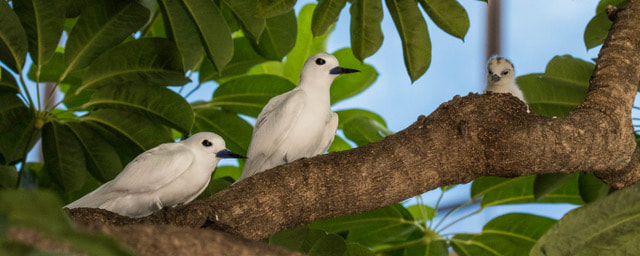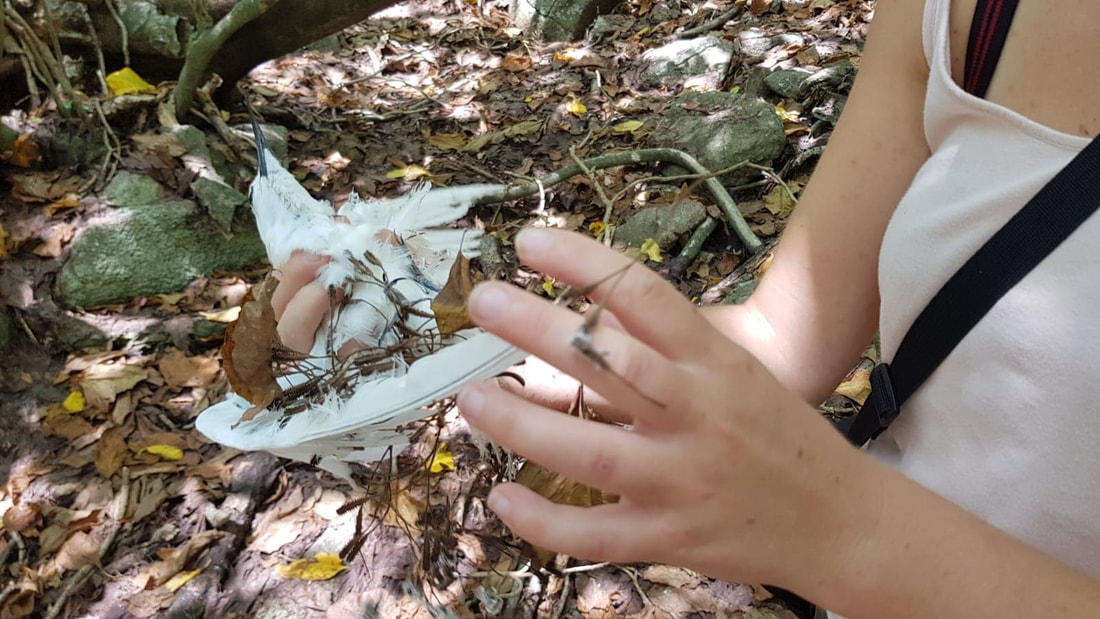|
The 2019 White Tern breeding season on Oahu continues to provide numerous outstanding viewing opportunities. Join us on Saturday, June 22, from 9:00 to 10:30 for a walk that will take in some of the best of the best white tern nests in the heart of Waikiki. Meet behind the stage at the base of the big banyan tree at the Royal Hawaiian Center on Kalakaua Avenue at 9:00 if you'd like to join us. Please RSVP by text to 808-379-7555.
Elena Levorato spent a couple of months this past winter learning about and assisting with seabird rehabilitation as an intern at the Hawaii Wildlife Center. Part of her training involved tending and feeding white tern chicks that were finishing their rehabilitation and reintroduction into the wild at the Honolulu Zoo. Since her stint as an intern on the big island and Oahu she has since moved on to the Seychelles where she continues to learn about seabirds of the Pacific and their conservation. Elena recently sent back to the Hui Manu o Ku a fascinating report on the white terns living and breeding on Aride Island in the Seychelles and a very specific threat they encounter there. Below is her report on the white terns and the Pisonia tree on Aride Island.
Hello everyone! I know that this page is mostly dedicated to white terns from Honolulu, but I think it would be interesting to also talk about those who live elsewhere in the world. On Aride Island (Seychelles) there are lots of white terns, everywhere! Sadly, the breeding success is very low compared to those from Hawaii, even if there are no predators (no cats, no rats, no dogs) on the island. The reason of this low success is unclear, but the presence of Pisonia grandis does not help the terns’ population. Pisonia is a tropical tree mainly found on tropical islands in the Indian and Pacific oceans. Seabirds love to nest on this tree, especially the lesser noddies (Anous tenuirostris) and the white terns (Gygis alba). If this tree provides a good shelter, it has a trap: the sticky seeds. When the seeds are mature, they fall on the ground and stick very easily to the feathers. During this period of the year, it is common to see noddies, tropicbirds and white terns on the ground, unable to fly because the wings and the tail are covered with seeds. This dramatic scenario is actually a natural way the tree uses to disperse the seeds, and it was hypothesized that bird carcasses could be a good fertilizer to help new plants to develop. However, more researches are needed to better understand this phenomenon. The staff from ICS (Island Conservation Society) working on this island, try to help the birds found in distress, when this is possible. However, it is not a simple task: the seeds have small spines and a sticky substance, so it is better to be two people, one holding the bird and the second trying to remove the seeds without pulling out the feathers. For more information regarding Pisonia grandis, click on those links: https://daily.jstor.org/the-bird-catching-pisonia-trees/ https://www.sciencealert.com/this-tree-seems-to-kill-birds-just-for-the-heck-of-it For more information regarding Aride Island, visit the following link: https://www.arideisland.com/ |
Archives
February 2024
Categories |

